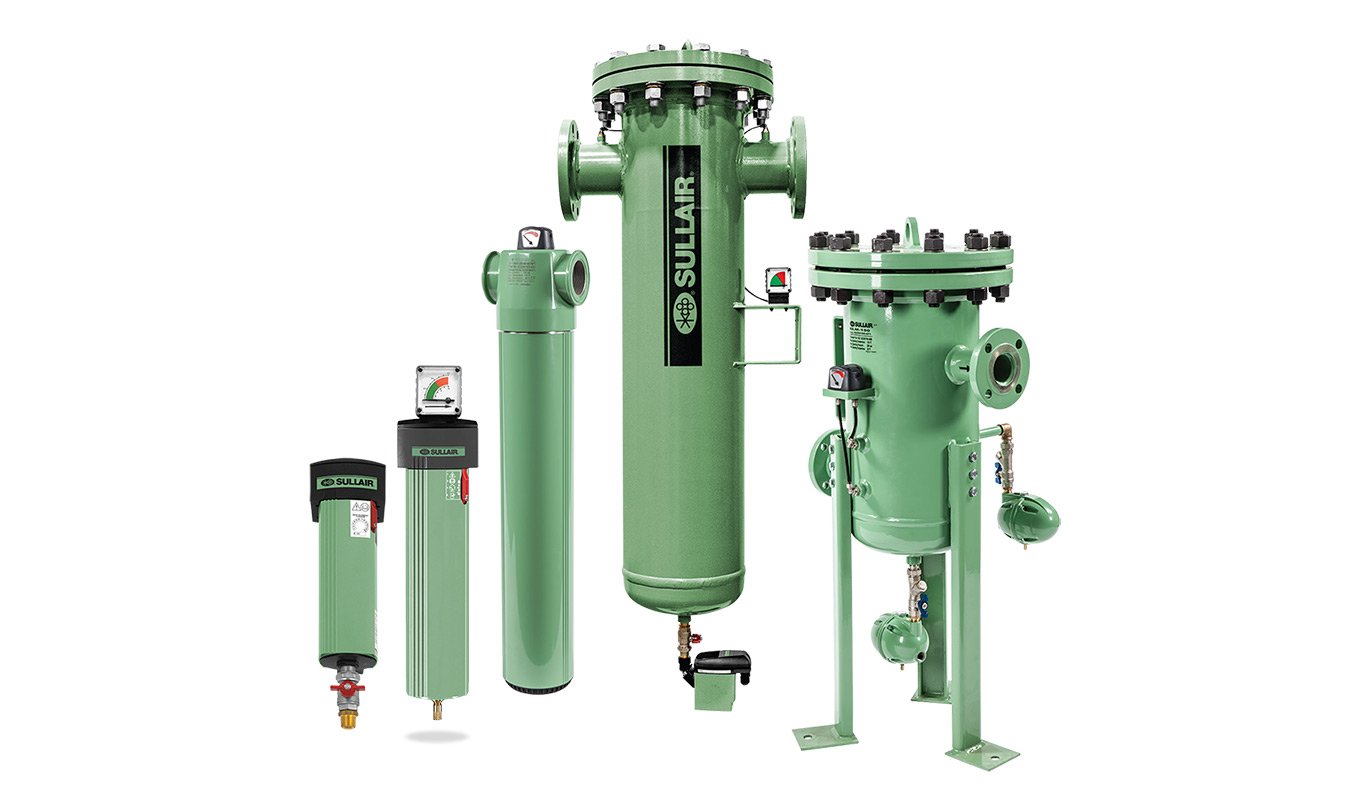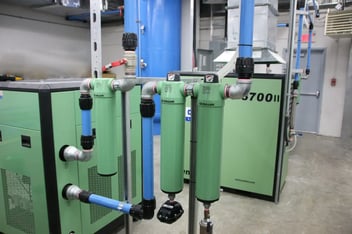Why You Might Need an Inline Filter For Your Compressed Air System

Most compressed air systems rely on a primary filter at the compressor to remove dirt, oil, and moisture. But that first line of defense isn’t always enough. Contaminants can still slip through and cause damage at the point of use, where your equipment, tools, or production lines need the cleanest possible air.
That’s where inline filters come in. Installed directly at the application point, inline filters provide targeted protection by capturing any remaining particles, aerosols, or vapors before they reach sensitive equipment.
Let’s explore how inline filters work, why they’re critical for maintaining air quality, and which types are best suited for different applications and industries.
What Is an Inline Filter?
An inline filter is a filtration device installed directly in the air line of a compressed air system, typically right at the point of use.
Its main job is to capture any remaining contaminants, such as dust, oil aerosols, water droplets, or vapors, that weren’t removed by the system’s primary filter at the compressor.
Inline filters are designed to provide this “last step” of protection. By being positioned at or near the application point, they ensure that the air delivered to sensitive tools, machines, or production processes is as clean and dry as possible.
- While a primary compressor filter handles the bulk of contaminants entering the system, it isn’t always enough. Contaminants can enter downstream through leaks, piping, or even as residue bypassing the initial filter. This is where inline filters make a critical difference.
Inline Filter vs. Primary Compressor Filter
Here’s a quick breakdown of how the two types of filters differ:
|
Feature |
Primary Compressor Filter |
Inline Filter (Point-of-Use) |
|
Placement |
Installed at the compressor |
Installed at or near the application point |
|
Main Purpose |
Removes large amounts of dirt, oil, and water |
Provides targeted protection for sensitive tools |
|
Contaminant Control |
General bulk removal |
Fine/secondary removal of particles, aerosols, vapors |
|
Air Quality Level |
Standard filtration |
High-quality air for critical applications |
|
Best For |
System-wide protection |
Point-of-use, industry-specific requirements |
Why Inline Filters Are Critical
Compressed air can still contaminate your equipment and end products, even with a strong primary filter. Inline filters add a critical layer of defense, delivering clean, reliable air where it matters most.
Here’s why they’re essential:
- Protect Sensitive Equipment – Inline filters stop dust, oil, and water that may slip past the primary filter, preventing costly damage to pneumatic tools, automation systems, and delicate machinery.
- Improve Air Quality – By removing fine particles, aerosols, and moisture, inline filters ensure clean, dry air is consistently delivered to production lines, processes, or end-use applications.
- Extend Equipment Lifespan – Cleaner air means less wear and tear on tools and machinery, reducing downtime and maintenance costs while maximizing system efficiency.
- Meet Industry Standards – Certain industries (pharmaceutical, food & beverage, electronics, etc.) require exceptionally pure air to meet compliance and quality standards. Inline filters help facilities achieve these strict requirements.
Types of Inline Filters for Compressed Air Systems
Not all contaminants are the same, and neither are filters. Inline filters come in different types, each designed to handle specific challenges in a compressed air system.
Choosing the right one depends on your application and industry needs:
- Particulate Filters
Capture dust, dirt, rust, and other solid particles.
Best for: General manufacturing and applications where protecting pneumatic tools or equipment from abrasive wear is the priority. - Coalescing Filters
Remove oil aerosols and fine liquid contaminants that a standard filter may miss.
Best for: Industries with sensitive equipment (automation, electronics, automotive) where oil contamination could cause performance issues. - Activated Carbon Filters
Eliminate odors, vapors, and hydrocarbons by adsorbing them into carbon media.
Best for: Food, beverage, and pharmaceutical industries where taste, odor, and purity are critical. - Moisture Traps / Water Separators
Target and remove water droplets at the point of use.
Best for: Applications in humid environments or processes where moisture can cause corrosion, product defects, or equipment malfunctions.
Industries & Applications That Benefit Most from Inline Filters
Inline filters aren’t just an upgrade. For many industries, they’re a necessity. From protecting equipment to meeting compliance standards, these filters ensure compressed air is clean, dry, and reliable where it matters most.
- Manufacturing & Assembly – Protects pneumatic tools, automation equipment, and robotics from contaminants that could lead to malfunctions or premature failure.
- Food & Beverage – Maintains hygienic, contaminant-free air for processes where purity directly impacts product safety and taste.
- Pharmaceutical & Medical – Ensures compliance with strict air quality regulations and prevents product contamination during sensitive manufacturing processes.
- Electronics – Guards against microscopic particles that could damage delicate components or cause costly defects.
- General Industrial Use – Reduces downtime and maintenance costs across a wide range of applications, keeping systems running smoothly and efficiently.
How to Choose the Right Inline Filter
Not every application requires the same level of air purity, so choosing the right inline filter is critical. A mismatched filter can underperform or cause unnecessary pressure drop, hurting system efficiency.
Here are a few factors to keep in mind:
- Application Requirements – Sensitive industries like pharmaceuticals, food, and electronics need higher levels of filtration, while general manufacturing may only require basic particulate removal.
- Level of Filtration Needed – Decide whether you need to target solids (dust, rust), liquids (oil, water), or vapors (hydrocarbons, odors). In some cases, a combination of filters may be required.
- Airflow and Pressure Drop – Inline filters should deliver clean air without restricting flow. Always verify the filter’s capacity matches your system’s demand.
- Expert Guidance – Work with a compressed air specialist to assess your system and select a filter that balances performance, efficiency, and cost-effectiveness.
FAQ: Choosing the Right Inline Filter
Q: Do I need an inline filter if I already have a compressor filter?
A. Yes. Compressor filters catch most contaminants, but inline filters provide targeted, point-of-use protection where the cleanest air is most important.
Q: Can I use more than one type of inline filter?
A. Absolutely. Many systems use a combination — for example, a coalescing filter for oil removal paired with a carbon filter for odor control.
Q: How often should inline filters be replaced?
A. It depends on your operating environment, but regular maintenance checks are key. Most filters need replacement every 6–12 months, or sooner in demanding conditions.
Q: Will an inline filter affect system pressure?
A. Quality filters are designed to minimize pressure drop, but improper sizing or clogged filters can cause restrictions. Monitoring and regular maintenance will prevent this.
Keep Your Compressed Air Clean Where It Counts
Primary compressor filters do a lot of the heavy lifting, but can’t always guarantee the air quality your applications demand. Inline filters provide that critical last layer of protection — keeping contaminants out of your tools, processes, and end products.
If you’re unsure whether your system is getting the cleanest possible air, now’s the time to evaluate your setup.
Contact TMI today to find the right inline compressed air filter for your application and keep your operations running at peak efficiency.


